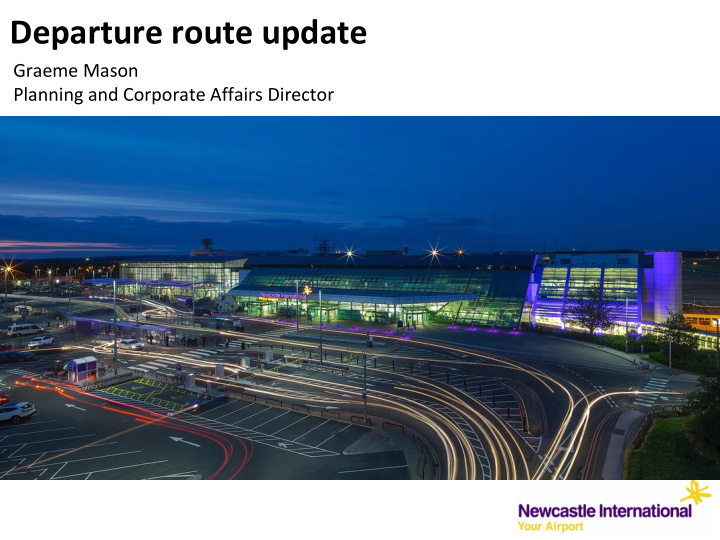



Departure route update Graeme Mason Planning and Corporate Affairs Director
Presentation agenda • Existing departure route • Routes assessment – Operational considerations – Airspace requirements – Noise implications • Decision process • Future work
Existing departure route
Alternative routes - operational impacts • Increase in track miles flown would result in:- – Additional aircraft fuel burn by airlines. – More direct CO 2 emissions due to increased fuel use. – Additional fuel costs, affecting the viability of certain routes. • Runway capacity constraints:- – Current route allows for separation which increases runway movement take-off rate. – Depending on aircraft type, faster aircraft would have to wait up to 10 mins before taking off (after slower aircraft) due to aircraft separation requirements.
Airspace requirements • NIAL Air Traffic Control assessment has confirmed that the current controlled airspace is suitable for existing operations. • Additional airspace is not required until annual aircraft movements reach 80,000 – 100,000. Current number of movements is 55,600 (the lowest since 2006). • Any changes to aircraft routes would require an Airspace Change Proposal (ACP, as set out in CAP 1616) to be done in conjunction with national airspace expansion plans. • An ACP process would take 5+ years.
Noise implications • An assessment of noise implications of alternative routes has been carried out. • The alternative routes considered would deliver no reduction in the number of people impacted within the noise contours. • People living on the northern edge of Heddon on the Wall would experience more aircraft.
Decision process • NIAL has now considered the Osprey report and the internal assessment. • A decision has been taken not to proceed with an alternative departure route, based on the following key points:- – Impact on operations, including runway restrictions. – No reduction in the number of people affected by noise. – Detrimental impact on air quality with an increase in CO 2 emissions. – Increase in fuel costs that could impact on route viability. Loss of routes would damage the North East. – An ACP is a major undertaking and to date no other UK airport has completed the CAP 1616 process. At best, the timescale would be 5+ years.
Future work • Investment in WebTrak:- – Web based tool to allow residents to monitor aircraft routeings via the airport website. – Residents will be able to view all aircraft tracks in relation to their property and directly obtain information on noise. – Training sessions will be provided to residents. • Periodic review of departure routes to assess their impact and also consider new and emerging guidelines. • Continue to make representations regarding any new housing development planning applications. • Report all noise complaints to Executive Team on a regular basis.
QUESTIONS
Recommend
More recommend